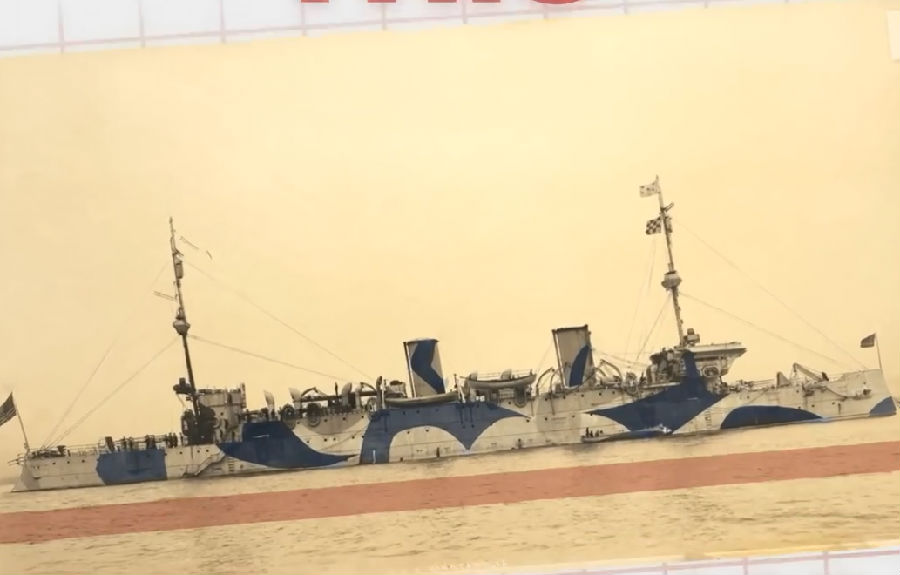(单词翻译:单击)
This is camouflage. And during World War One, this ship was not alone.
这种图案叫迷彩。一战期间,采用迷彩的并不只有这艘船。
It was called "dazzle camouflage", and the irregular shapes were paired with bright colors, like this blue.
这种迷彩叫“眩晕迷彩”,人们还会给这些不规则的形状配上鲜艳的颜色,比如这种蓝色。
So when artists painted scenes like this or this, they weren’t just playing with paint.
所以,当画家们画出这种或这种内容时,他们并不只是在对色彩进行试验,
They were showing the final defense that hundreds upon hundreds of ships used...against torpedoes.
而是在展示上万艘船只为对付鱼雷而使用的终极防御系统。
British artist Norman Wilkinson painted scenes like these and specialized in nautical pictures.
英国画家诺曼·威尔金森画下的内容包括这些,他专攻的是航海画。
He ran the Royal Navy’s camoufleur program. Yes - “camoufleur.” One who...camouflages.
英国皇家海军的迷彩专家项目就是他负责的。没错,“迷彩专家”就是专门制作迷彩的人。
Previous camoufleurs had tried shades of grey or blue,
在威尔金森之前,迷彩专家们使用的都是灰色系或蓝色系的迷彩,
but Wilkinson suggested dazzle: unpredictable patterns, with a range of colors.
威尔金森便提出了“眩晕迷彩”的概念:即在毫无规律的图形上涂上各种色系的颜色。
There were some really bright ones.
其中会用到一些比较明亮的色系。
Hiding a ship was hard.
要想让一艘船隐形是很困难的。
The ocean and sky were constantly changing colors, and that made it hard to pick a single shade of paint that could help a ship slip by unnoticed.
因为海洋和天空的颜色时刻都在变化,所以要想找出一种颜色来帮一艘船神不知鬼不觉地避开攻击是很困难的。
But it was possible to hide what the ship was doing.
但这么做还是可以掩盖那艘船正在做的事情。
The U-Boat submarine and torpedoes were the big new threat in World War I.
一战期间,U型潜艇和鱼雷是当时威力巨大的新式武器。
But the u-boat had limitations.
然而,这种潜艇也有很多缺陷。
To shoot a torpedo, you needed to know the angle, distance, and speed of the ship you were shooting at.
比如发射鱼雷之前,潜艇需要知道目标船只的角度、位置和航行速度。
The ship was moving and so was the submarine.
目标船只在动,潜艇也在动。
Now imagine a ship through a periscope from a thousand meters away.
试想从潜望镜中观测到一艘位于一公里以外的目标船只,
When you...dazzled...a ship, you made it hard for u-boats to know where to aim.
当你给一艘船涂上眩晕迷彩时,U型潜艇就不知该往哪儿瞄准。
Here is a normal boat and a dazzled boat.
这是一艘普通的船只和一艘涂了眩晕迷彩的船只。
On the normal boat, you can see the bow and stern, and you can gauge key attributes to guess at the speed.
拿这艘普通船来说,大家可以清楚看到船的首尾,也能通过估计主要的参数推断出其航速。
It’s a lot harder on the dazzled boat.
但换成涂了眩晕迷彩的船就困难多了。
Lines like these were false waves, so it was hard to guess which direction was the bow, or front of the boat, and where it was going.
这种线条可能被误以为是海浪,这就很难猜测船头的方向以及哪里是船的前身,哪个方向是船的航向。
The colors made it hard to tell how quickly the boat was moving from one point in the view to another,
这些颜色让人很难辨别船从视域中的一点到另一点的航行速度,
or to use a rangefinder to guesstimate its distance.
也很难用测距仪来大致推断其位置。
Everything looked...sort of wrong under dazzle patterns, which made a ship’s course tough to assess.
有了眩晕迷彩,所有的数据似乎都错了,要推测船只的航向就很困难了。
Is it going this way? Or is it going this way? A few degrees could be the difference between life or death.
是朝这边开的吗?还是朝这边开的?仅仅几度的差距就可能决定一艘船的命运。
You could see it, but you couldn’t guess direction or speed to guide your torpedo.
你能看到它,却无法猜出其航向和航速,也就无法给你的鱼雷导航。
Dazzle patterns were always different and kept top secret.
眩晕迷彩的具体图案往往是彼此不同的,而且属于最高机密。
The starboard and port sides were designed to be unpredictable.
船只的左右舷的设计也是没有规律的。
Modelers even tested visibility using tiny boats and simulated periscopes, just to see what was most confusing.
模型师们甚至会用迷你的船只模型和模拟的潜望镜来测试这些船只的可见性,从而找出效果最好的迷彩设计。
This is warfare at its cutest.
这可以说是战争最可爱的部分。
Even experts were fooled by the direction of the ship.
就连专家也会被船只的航向迷惑。
Out in the ocean, tricking a torpedo saved lives.
在茫茫大海上,迷惑鱼雷则能够挽救很多人的生命。
Dazzle camo inspired people from all disciplines as it traveled worldwide.
随着眩晕迷彩在世界各地的普及,各行各业的人都从这种迷彩上获得了灵感。
One zoologist claimed to have invented it, inspired by zebras,
某动物学家声称这种迷彩是他在受到斑马纹的启发之后发明的。
British artists with cubist-inspired backgrounds became camoufleurs,
英国立体派画家也成了迷彩专家,
and photo-scientists in America made their own models too, like in this 1919 MIT thesis.
美国的摄影家也制作了他们自己的模型,比如这篇1919年的麻省理工论文里的这款模型。
Even the sister ship to the Titanic became..dazzling, when it was turned into a troopship.
连泰坦尼克号的姊妹船在变成军舰以后也被涂上了这种迷彩。
At the end of World War I, periscopes and weaponry improved, as well as strategies to deter u-boats.
一战结束后,潜望镜和武器变得更加先进,连对付U型潜艇的战略方案都升级了。
On the other end, dazzle paint was hard to maintain.
眩晕迷彩则开始难以为继。
Radar furthered the decline of dazzle’s utility, though the camo was used in World War II on ships and even on planes.
雷达更是挤压了眩晕迷彩的用处,尽管二战期间这种迷彩仍被用到了战船甚至是战斗机上。
Dazzle inspired fashion trends at the time and the artists who painted it on ships.
然而,曾经的眩晕迷彩不仅给当时的时尚潮流提供过灵感,一些画家也曾在受到这种迷彩的启发后将其应用在船身上。
Norman Wilkinson made this painting of the dazzled ships he helped make mainstream.
诺曼·威尔金森画下了这幅涂了眩晕迷彩的船,正是在他的带领下,这种迷彩的船才成了当时的主流。
The u-boat’s rise and particular weaknesses opened a unique window in history, like a camouflage loophole.
U形潜艇的崛起,尤其是其弱点像一个伪装的漏洞一样为我们打开了一扇独特的历史之窗。
For a brief period, it made sense to stand out. Paint fades. But even today, dazzle lives up to its name.
短短时间内,这种迷彩就从原来的单色迷彩中脱颖而出。尽管再艳丽的画终究都会褪色。但即便是今天,迷彩也是不负盛望的。
So if you look at these dazzle ships and think about cubism, you aren’t wrong to make the connection, and you aren’t the only one.
大家要是看到这些眩晕迷彩的船只时联想到了立体主义画派,那你这种联想并没有错,而且也不是只有你才会这么联想。
Pablo Picasso tried to take credit — eh, he might have had a point.
毕加索也想过把这个功劳划到自己名下,嗯,他这么做或许也不算是毫无道理的吧。


